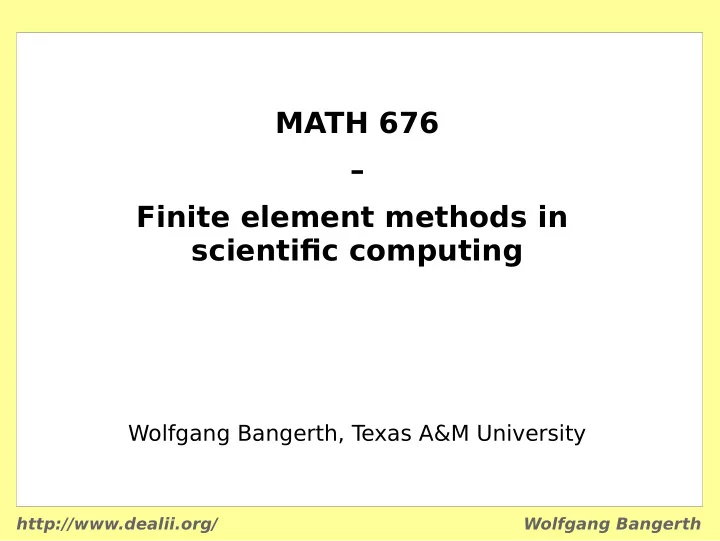

MATH 676 – Finite element methods in scientifjc computing Wolfgang Bangerth, T exas A&M University http://www.dealii.org/ Wolfgang Bangerth
Lecture 17.5: Generating adaptively refjned meshes: Which cells to refjne http://www.dealii.org/ Wolfgang Bangerth
Adaptive mesh refjnement (AMR) Adaptive mesh refjnement happens in a loop: SOLVE → ESTIMATE → MARK → REFINE ● SOLVE: Assemble linear system, solve it ● ESTIMATE: Compute a refjnement indicator for each cell ● MARK: Determine which cells should be refjned ● REFINE: Refjne these cells (and possibly others) http://www.dealii.org/ Wolfgang Bangerth
The MARK phase Precondition: In the ESTIMATE phase, we have computed a refjnement indicator for each cell: η = {η K 1 , η K 2 , η K 3 , ... , η K N } Goal: Determine which cells need to be refjned to obtain the next mesh! http://www.dealii.org/ Wolfgang Bangerth
The MARK phase Strategy 1 (“global refjnement”): Mark all cells for refjnement. Advantages: ● Convergence is guaranteed ● Don't even need to compute the refjnement indicators Disadvantages: ● Not an optimal strategy: requires more cells than necessary http://www.dealii.org/ Wolfgang Bangerth
The MARK phase Strategy 2 (“bulk refjnement”, “fjxed fraction”): Mark those cells for refjnement that (i) have the largest error indicators, (ii) together account for a certain fraction of the error (e.g., 90%). Advantages (at least for some equations): ● Convergence can be guaranteed theoretically ● Can be shown to lead to optimal meshes Disadvantages: ● May sometimes refjne very few cells (at “singularities”) ● Can be expensive in these cases http://www.dealii.org/ Wolfgang Bangerth
The MARK phase Strategy 3 (“fjxed number”): Mark a fjxed fraction of the cells for refjnement that have the largest error indicators. (For example, refjne 1/3 of cells in 2d, 1/7 of cells in 3d.) Advantages: ● Number of cells is guaranteed to grow at a reasonable pace Disadvantages: ● May not lead to optimal meshes ● May refjne too many cells http://www.dealii.org/ Wolfgang Bangerth
The MARK phase Observation: We typically mark cells based on ● Heuristically derived error indicators ● Error estimators that overestimate the true error Consequence: We sometimes refjne the wrong cells! Solution: In each refjnement step, also coarsen a small number of cells (e.g., 5% of cells) to undo earlier mistakes. http://www.dealii.org/ Wolfgang Bangerth
The MARK phase Implementation: The 3 strategies for refjnement are implemented in the following functions: ● Triangulation::refjne_global() ● GridRefjnement::refjne_and_coarsen_fjxed_fraction() ● GridRefjnement::refjne_and_coarsen_fjxed_number() Each of these increases the number of cells. If the refjnement indicators are good, each will eventually yield convergence of the error to zero. http://www.dealii.org/ Wolfgang Bangerth
Time dependent problems Time-dependent equations (see, for example, step-26, lecture 30): ● Start with a coarse mesh in time step 1 ● Refjne it a number of times to resolve the solution ● Do time iteration ● Every few time steps, adjust the mesh: – start with the mesh from the previous time step – coarsen and refjne some cells – roughly keep number of cells constant Requires “fjxed number” strategy: Mark proportional numbers of cells for refjnement and coarsening. http://www.dealii.org/ Wolfgang Bangerth
A difgerent perspective Consider this mesh: We can say: Compared to a uniform mesh, we selectively refjned to make the solution far more accurate! http://www.dealii.org/ Wolfgang Bangerth
A difgerent perspective Consider this mesh: Or we can say: Compared to a uniform mesh, we selectively coarsened to make the computation far cheaper! http://www.dealii.org/ Wolfgang Bangerth
A difgerent perspective An illustration in a graph: We can say: Compared to a uniform mesh, we selectively refjned to make the solution far more accurate! http://www.dealii.org/ Wolfgang Bangerth
A difgerent perspective An illustration in a graph: Or we can say: Compared to a uniform mesh, we selectively coarsened to make the computation far cheaper! http://www.dealii.org/ Wolfgang Bangerth
MATH 676 – Finite element methods in scientifjc computing Wolfgang Bangerth, T exas A&M University http://www.dealii.org/ Wolfgang Bangerth
Recommend
More recommend